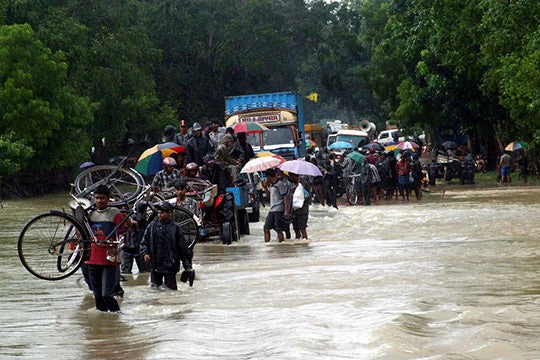The 2004 Indian Ocean Tsunami – Triggering engagement in Disaster Risk Management (DRM)
In 2004 December, Sri Lanka faced the worst disaster in its history - the Indian Ocean Tsunami. More than 35,000 people lost their lives and around 5,000 people went missing. At the time of the Tsunami, Sri Lanka did not have a proper legal and institutional mechanism to manage disaster risk. In the aftermath of the catastrophe, the Government made very serious efforts to establish a mechanism to avoid dramatic loss of life in future disaster events.
Subsequently, the Disaster Management Act was passed and the National Council for Disaster Management, chaired by the President, was established. A Ministry of Disaster Management (MoDM) was created and charged with the disaster risk management (DRM) portfolio and the Disaster Management Centre (DMC) was established July 2005 to implement DRM programs across the country.
With these mechanisms in place, the Government began strengthening disaster preparedness, especially for tsunamis. Three pieces were put in place including: i) development of a tsunami early warning system; ii) implementation of awareness raising programs, from the grassroots to national levels; and, iii) regular evacuation drills were conducted in all coastal villages. The system has proven successful as the DMC issued Tsunami evacuation warnings in September 2007 and April 2014, which resulted in the safe evacuation of coastal communities.
However, tsunamis do not regularly occur and Sri Lanka faces regular flood landslide events; although, unfortunately, the economic impacts of these events are not assessed. For example, in February 2011, torrential rains resulted in a major flood that affected half the country. Parliament flooded, while roads, housing and agriculture were hard hit. The vulnerable were the most impacted by this event: rice farming is the predominant livelihood the impacted population and the flood destroyed the paddy crop. This resulted in a major livelihood and food security problem challenge that focused government attention on economic and disaster loss.
The following year, the North East monsoon and the first inter-monsoon failed, leading to a drought in almost all the districts affected by 2011 February floods. The same farmers that lost the paddy crop of one season and lost much of the next year’s crop. Yields fell dramatically and the most vulnerable found themselves in a vicious poverty cycle due to these disasters.
As a result of these events, the Secretary to the Ministry of Finance and Planning (MoFP) expressedthat that the treasury strongly felt the economic impacts of the floods of 2011 and the drought of 2012. To address this request, the President requested the MoDM to begin developing property and crop insurance products with private insurance companies.
In essence, the Government shifted focus on the need to address disasters from the importance of saving lives to the urgency of protecting assets from negative economic and fiscal impacts. Given this opportunity, the Bank team began a dialog with the MoFP on strengthening the physical and fiscal resilience for adverse climatic events. The MoDM and the DMC were excited to work with the team risk financing and insurance given the limited support they received from other development agencies in this area of DRM.
Following the successful discussions with the MoFP, and other key line ministries, the World Bank and the Global Facility for Disaster Reduction and Recovery (GFDRR) team developed the “Comprehensive Approach to Climate Risk Management” addressing both the physical and fiscal risks comprising short to long term engagements.
Putting in place the Climate and Disaster Resilience Program
The team prepared two projects; i) Climate Resilience Improvement Project (CRIP) a $110 million IDA IPF and; ii) Development Policy Loan with the Catastrophe Deferred draw Down Option (CATDDO) a $102 million IBRD contingent line of credit.
The CRIP addresses both short term and long term climate risks by financing immediate risk mitigation needs in short term and analytical risk modeling studies to development flood and drought mitigation investment program to address the climate risks long term. These analytical studies will lead to a larger climate resilience investment program that will be financed by the bank and the other donors. Most importantly, the analytical component will take a comprehensive approach to risk mitigation with a full-fledged risk assessment.
The CATDDO will provide financing in the immediate aftermath of a disaster to provide the government with liquidity until the other sources of financing are tapped into. The proceeds could be withdrawn upon declaration of a state of an emergency by the President as per the provisions in the Disaster Management Act. The CATDDO is just a part of the Disaster Risk Financing program. A Fiscal Disaster Risk Assessment has been started to help government to develop a Disaster Risk Financing and Insurance Strategy. The Fiscal Disaster Risk Assessment report will provide recommendation on fiscal mechanisms that can be put in place to address disaster events with different severity. I.e. i) annual budget allocations for annual disaster risks; ii) contingent financing such as CATDDO for medium scale risks; and iii) insurance mechanisms to address high impact disasters.
Read the Press Release
Check out the Project Highlight
Photo Credit: By trokilinochchi (originally posted to Flickr as 146), via Wikimedia Commons




Join the Conversation